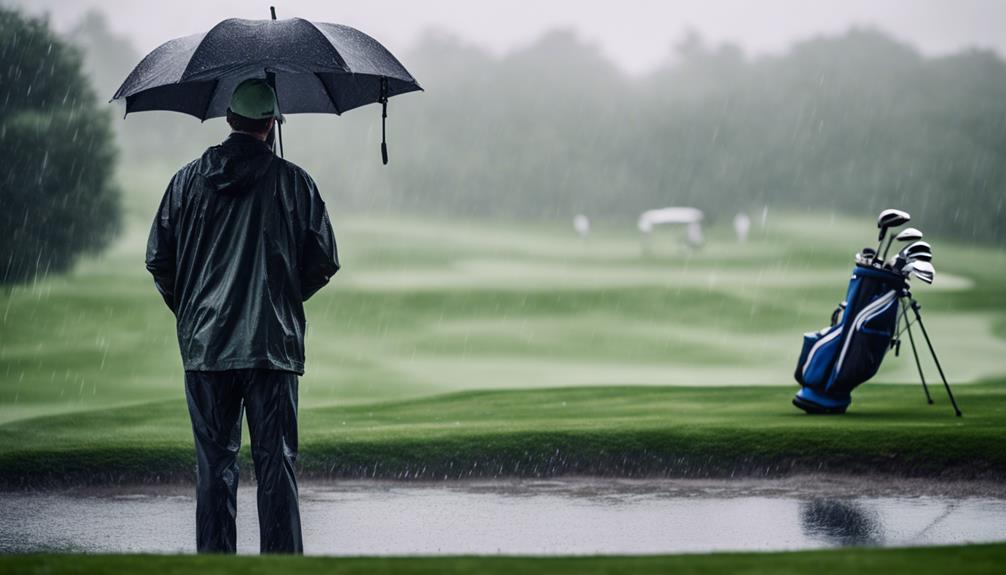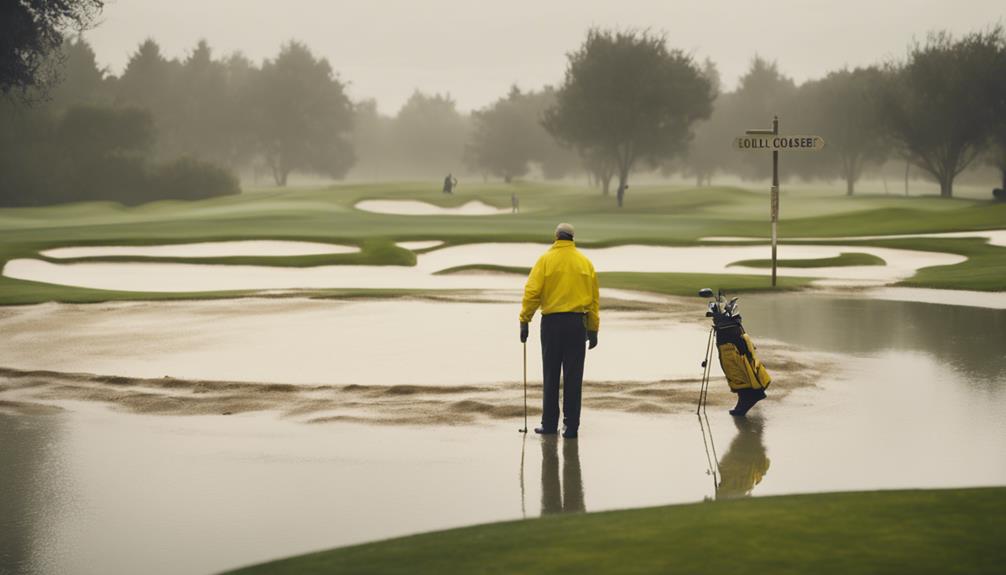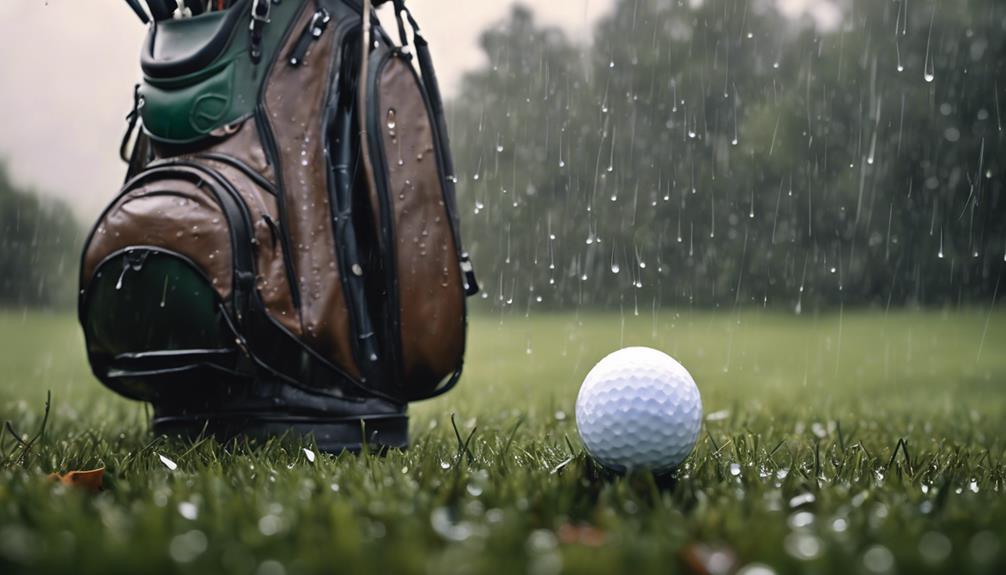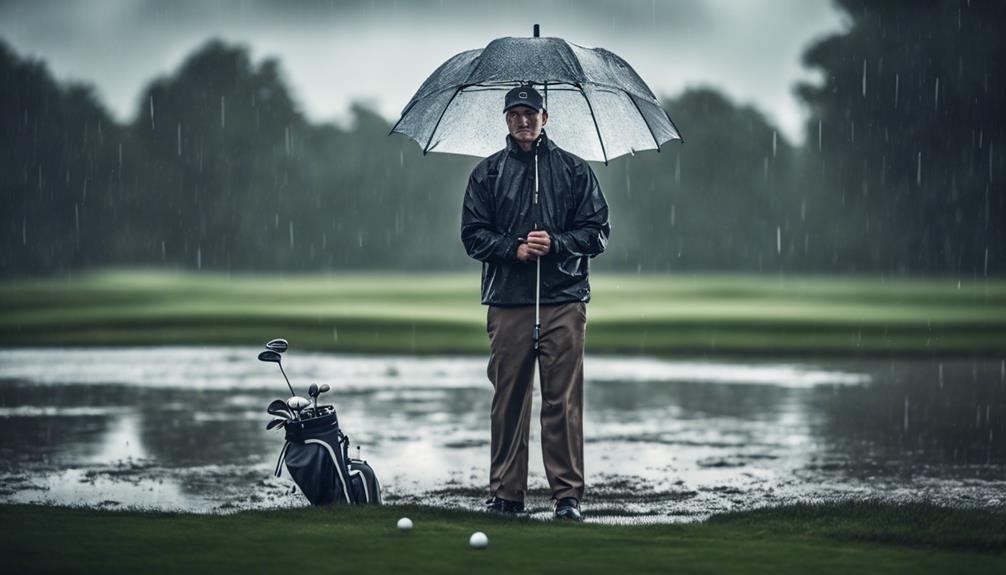- 7 Top Flite Golf Clubs XL for Improved Performance - September 28, 2024
- Top Flite Golf Clubs: Top 5 Reasons to Choose Them - September 28, 2024
- Top 3 Golf Club Fitters for a Perfect Swing - September 28, 2024
When you're planning a round of golf, rain can be a major buzzkill. Heavy rain can cause course closures due to infrastructure damage, player safety concerns, and environmental hazards. Flooded bunkers, erosion, and compromised playing surfaces are just a few reasons why courses shut down during heavy rain. Slipping and falling on the greens, getting struck by lightning, and waterlogged fairways are all risks that golf courses mitigate by closing during bad weather. You'll want to know more about how golf courses prepare for and respond to rain – and what it means for your game.
Key Takeaways
- Yes, golf courses may close due to heavy rain, prioritizing player safety and preventing infrastructure damage.
- Rain can cause course closures due to flooded bunkers, compromised playing surfaces, and inoperable maintenance equipment.
- Excessive water can lead to fertilizer and pesticide runoff, contaminating nearby waterways and harming local ecosystems.
- Playing golf in the rain increases the risk of slipping and falling, with lightning strikes also becoming a significant hazard.
- Course closures during heavy rain mitigate these risks, safeguarding the long-term health of the course and ensuring a safe playing environment.
Rain-Related Course Closures Explained
When heavy rain hits, you may find yourself wondering why golf courses shut down, and it's not just because of puddles on the greens. The reality is that rain-related course closures are often necessary to prevent long-term damage to the course's infrastructure and protect player safety.
As a golfer, you might think that a little rain wouldn't hurt anyone, but the truth is that excessive water can wreak havoc on the course's drainage system, leading to erosion, flooded bunkers, and compromised playing surfaces.
Additionally, rain can also make the course's maintenance equipment inoperable, hindering the grounds crew's ability to prepare the course for play.
In addition to these physical challenges, rain can also impact the course's environmental sustainability.
Excessive water can lead to fertilizer and pesticide runoff, contaminating nearby waterways and harming local ecosystems.
By closing the course during heavy rain, golf course managers can mitigate these risks and safeguard the long-term health of the course.
Dangers of Playing Golf in Rain
As you step onto the rain-soaked course, you're faced with a multitude of hazards that can quickly turn a round of golf into a safety nightmare.
You're not just battling the elements, you're also contending with slippery greens that can send you tumbling and lightning strike risks that can be deadly.
Protecting yourself from harm and taking necessary precautions to safeguard your well-being on the course is crucial.
Slippery Greens Ahead
Playing golf in the rain increases your risk of slipping and falling on the greens, which can lead to injuries and embarrassing moments on the course.
You might think that the rain-soaked grass would provide better traction, but it's actually the opposite. The wet conditions make the greens slippery, and the grass becomes more prone to divots, which can cause your feet to slip out from under you.
This is especially true around the hole, where the grass is typically shorter and more densely packed.
As you navigate the course, be extra cautious when walking on slippery greens. Take smaller steps, keep your weight centered, and avoid sudden movements.
It's also essential to wear golf shoes with good grip and traction to help prevent slipping. Keep in mind that even with precautions, accidents can still happen.
If you do slip and fall, prioritize your safety and take a moment to assess any injuries before continuing play. Remember, it's always better to err on the side of caution when playing golf in the rain.
Lightning Strike Risks
You face a far greater threat than slippery greens when playing golf in the rain: the risk of being struck by lightning. The odds of being struck are about 1 in 700,000, but they increase to 1 in 55,000 when you engage in outdoor activities like golfing during thunderstorms.
In the United States, an average of 47 people are killed by lightning each year, with many more injured, often with lifelong debilitating effects.
The Royal Meteorological Society reports that the UK experiences an average of 300,000 lightning flashes every year, with the majority occurring during summer thunderstorms, a peak time for outdoor activities like golf.
When lightning strikes, it can reach temperatures of up to 50,000°C, five times hotter than the surface of the sun, causing catastrophic damage to golf courses and posing a significant risk to golfers.
Take immediate action when you hear thunder or see lightning. Seek shelter in a sturdy building or a hard-topped vehicle, and avoid tall objects, metal fences, and conductive objects like golf clubs.
Don't take the risk – prioritize your safety and wait for the storm to pass.
Preparing for Rainy Day Golf

When you're planning to play golf in the rain, it's vital that you take necessary precautions to have a safe and enjoyable game.
You'll want to start by checking the forecast beforehand to anticipate the weather conditions you'll face on the course.
Check the Forecast
Before heading out to the golf course, you should check the weather forecast to determine if rain is likely to impact your game.
A reliable forecast will give you an idea of the probability of precipitation, wind direction, and speed. You can access forecasts through various sources, including websites, mobile apps, or television.
Look for forecasts that provide detailed information on the timing and intensity of the rain. This will help you plan your game accordingly.
When checking the forecast, pay attention to the percentage chance of rain, as well as the timing of the rain.
If there's a high chance of rain during your tee time, you may want to adjust your schedule or prepare for wet conditions. Additionally, consider the type of rain expected, such as light drizzle or heavy downpour.
This information will help you decide whether to bring rain gear, adjust your swing, or take other precautions. By checking the forecast, you'll be better prepared to tackle the challenges of rainy day golf.
Pack Essential Gear
Rainy day golf demands a well-stocked bag, featuring essential gear that'll keep you dry, comfortable, and focused on your game.
You can't afford to hit the links without the right gear, so make sure you're prepared. Start with a waterproof golf bag and rain jacket to keep your clothes dry.
Don't forget a hat and gloves to maintain your grip in wet conditions. A towel and rain cover for your clubs will also come in handy.
Invest in a good pair of waterproof shoes with traction to prevent slipping on wet grass. Additionally, bring extra socks and clothes in case you get soaked.
Having the right gear will give you confidence and allow you to focus on your game, even in the rain. Remember, a little rain shouldn't ruin your round – with the right gear, you'll be ready to take on the elements.
Pack smart, and you'll be able to tackle any rainy day golf challenge that comes your way.
How Rain Affects Golf Course Maintenance
Heavy rainfall puts immense pressure on greenkeepers, who must navigate the delicate balance between keeping the course hydrated and preventing waterlogged fairways and greens that can render the course unplayable.
As you know, heavy rain can cause courses to become waterlogged, leading to flooded fairways and greens, making it difficult for greenkeepers to maintain the course. Outdated drainage systems can exacerbate the issue, with courses built on clay-based soils being particularly vulnerable to waterlogging.
To mitigate this, effective drainage and irrigation systems are essential, and investment in improving these systems is necessary to prevent course closures.
As a golfer, you may not realize the complexity of maintaining a course during heavy rainfall. Greenkeepers must balance the need for water with the risk of flooding and damage, and agronomic practices can help reduce the risk of damage from heavy rainfall.
Courses with poor drainage may be forced to close for extended periods, causing frustration for golfers and impacting the long-term health of the course.
Safety Precautions for Golfers

When you step onto a rain-soaked golf course, you'll want to prioritize your safety above all else.
You need to be aware of the unique hazards that come with playing in wet conditions, and know what to do in case of an emergency.
Wet Conditions Precautions
As you prepare to tee off on a wet course, take a moment to assess the conditions and adjust your game plan accordingly to guarantee a safe and enjoyable round.
Wet weather demands extra caution to avoid injuries and equipment damage.
Start by selecting the right footwear with good grip to prevent slipping on wet grass.
Wear waterproof clothing and bring extra towels to keep your hands and grips dry.
Be mindful of your swing tempo and balance, as wet conditions can make the ground slippery and uneven.
When playing in wet weather, you must maintain a steady pace and avoid sudden stops or changes in direction.
Keep a safe distance from other golfers and be aware of your surroundings to avoid accidents.
Additionally, be prepared for slower play and potential delays due to course maintenance.
Course Closure Protocols
You should be aware that courses may implement closure protocols to promote golfer safety, prompting you to familiarize yourself with the specific procedures in place at your course. Course closure protocols are designed to ensure your safety and prevent accidents, so it's essential to understand them.
When a course is closed due to rain, it's not just about the inconvenience; it's about your safety. Heavy rain can lead to hazardous conditions, such as slippery surfaces, reduced visibility, and flooded areas.
To minimize risks, courses may implement the following protocols:
- Course inspections: Before reopening, courses will conduct thorough inspections to identify potential hazards, such as fallen trees, damaged bridges, or slippery surfaces.
- Signage and communication: Courses will display clear signage indicating course closures and provide timely updates through social media, websites, or mobile apps to keep you informed.
- Staff training: Course staff will receive training on emergency procedures, first aid, and crisis management to ensure they're equipped to respond to any situation.
Lightning Strike Procedures
Golf courses take lightning strikes seriously, and their lightning strike procedures are designed to protect you from the dangers of electrical storms. These procedures are put in place to safeguard your safety, and understanding what to do in case of a lightning strike is crucial.
When a lightning storm is approaching, golf courses will typically suspend play and evacuate golfers from the course. You'll be instructed to seek shelter in a safe location, such as a clubhouse or a hard-topped vehicle. Avoid being in open areas, near tall objects, or in close proximity to metal objects.
Here's what you can expect from a golf course's lightning strike procedure:
| Step | Action | Reason |
|---|---|---|
| 1 | Monitor weather forecasts and radar | Identify potential lightning storms |
| 2 | Use lightning detection systems | Alert staff and golfers of potential lightning strikes |
| 3 | Suspend play and evacuate golfers | Protect golfers from lightning strikes |
| 4 | Seek shelter in a safe location | Avoid being in open areas or near tall objects |
| 5 | Provide medical attention if necessary | Respond quickly and appropriately in case of a strike
Impact of Rain on Golf Course Drainage
How do outdated drainage systems compromise the integrity of golf courses, particularly those with clay-based soils, when faced with heavy rainfall?
As you navigate the course, you may notice that waterlogged areas are more prevalent due to the volume of rain overwhelming the natural drainage potential of soils and drainage systems. This issue is exacerbated by aging designs and compromised surface infiltration and upper profile percolation rates.
Key factors to examine:
- Outdated drainage systems are no longer fit for purpose, leading to waterlogged courses, with parkland courses with clay-based soils being particularly vulnerable to heavy rainfall.
- Soil saturation can render the course unplayable, depending on topography, soil type, and drainage system.
- Effective drainage and irrigation systems are vital in mitigating the impact of heavy rainfall, and agronomy and water management are critical aspects of golf course maintenance.
It's essential to maintain a balance between water management and drainage to prevent course closure. By understanding the impact of rain on golf course drainage, you can appreciate the importance of investing in modern drainage systems and effective water management strategies to safeguard the course remains playable and enjoyable, even in the face of heavy rainfall.
Rain's Effect on Golf Equipment

Heavy rainfall transforms the golf course into a hazardous terrain, where slippery greens, compromised club grip, and reduced visibility combine to challenge even the most skilled players.
As you navigate the course, you'll notice that rain makes greens slippery and mushy, affecting your grip maintenance and ball travel.
Additionally, the lack of grip on your clubs becomes a safety risk, especially in torrential downpours, as it can lead to accidents and injuries.
To combat this, consider wearing rain gloves, which provide a secure grip and prevent slipping, allowing you to maintain control over your clubs even in wet conditions.
In addition to grip, rain also affects your equipment's durability.
Waterproof golf bags and covers are essential to keep your gear dry and protected from rain damage, ensuring that your clubs and accessories remain in good condition.
By taking these precautions, you can minimize the impact of rain on your game and focus on adapting to the changed course conditions.
With the right gear and mindset, you'll be better equipped to tackle the challenges that rain brings to the golf course.
Dressing for Success in the Rain
As you prepare to tackle the rain-soaked course, prioritize dressing in attire that will keep you dry, comfortable, and confident, allowing you to focus on your game rather than the elements.
When it comes to dressing for success in the rain, prioritize gear that's both functional and comfortable.
You'll want to focus on:
- A rain jacket that's both waterproof and breathable, ensuring you stay dry without overheating
- Water-resistant pants that offer breathability and stretch for unrestricted movement
- Rain gloves that provide a secure grip and prevent slipping, allowing you to maintain control of your clubs in wet conditions
Course Closure Decision-Making Process

As a golfer, you're probably curious about the process behind course closure decisions. One essential aspect of golf course management is determining when to close the course due to rain, a decision that involves a thorough assessment of course conditions to safeguard player safety and prevent damage to the grounds.
When considering course closure, you'll typically see the course superintendent or manager conduct a thorough inspection of the course. They'll assess the severity of the rain, wind direction, and soil saturation levels to determine if play is still safe.
They'll also evaluate the likelihood of further damage to the course, taking into account factors like waterlogging, erosion, and potential hazards like fallen trees or broken branches.
The course closure decision-making process involves weighing these factors against the potential risks and consequences of keeping the course open.
If the risks outweigh the benefits, the course will be closed to prevent accidents and protect the course's integrity.
Rain's Impact on Golf Course Conditions
You've likely experienced the frustration of showing up to a soggy course, only to wonder how rain affects the grounds and ultimately, your game. Rain can profoundly impact golf course conditions, making it essential to understand its effects on the terrain.
Rain alters the playing surface, changing the way the ball rolls, bounces, and responds to your swing.
- Soft and Soggy Fairways: Rain-soaked fairways become soft and soggy, reducing ball roll and making it harder to control your shots.
- Slow and Heavy Greens: Wet greens slow down, becoming heavy and more challenging to navigate, especially when putting.
- Waterlogged Bunkers: Rain fills bunkers, making them difficult to play from, and potentially causing balls to plug or become stuck.
Understanding how rain affects course conditions is vital to adapting your strategy and technique to the weather conditions. By recognizing these changes, you can adjust your game to compensate for the rain's impact, ultimately improving your performance.
Playing Golf in Heavy Rainfall

Playing golf in heavy rainfall requires a combination of strategic adjustments and physical adaptations to overcome the hazardous conditions. When you're faced with a lot of rain, you need to adjust your game to compensate for the slippery surfaces, reduced visibility, and strong winds.
| Challenge | Solution |
|---|---|
| Slippery Fairways | Wear waterproof shoes with good grip |
| Reduced Visibility | Use a rangefinder or GPS watch to measure distances |
| Strong Winds | Take more club to account for wind resistance |
You'll also need to adapt your swing to account for the wet conditions. This means using a more controlled tempo, avoiding long backswings, and focusing on making solid contact with the ball. Additionally, be prepared to take more time to line up your shots and consider taking a more conservative approach to avoid risks. With the right mindset and adjustments, you can still enjoy a great round of golf even in heavy rainfall.
Adapting to Rainy Weather Conditions
To adapt to rainy weather conditions, focus on making calculated decisions about club selection, shot trajectory, and pace of play, as these factors will substantially impact your overall performance.
Inclement weather demands adjustments to your game, and failure to adapt can lead to a disastrous round.
When faced with rainy conditions, you'll need to:
- Adjust your club selection: Choose clubs with more loft to compensate for the reduced roll and increased height of your shots.
- Modify your shot trajectory: Aim for higher shots to allow the ball to land softly on the wet greens, reducing the risk of overshooting.
- Manage your pace of play: Be prepared for slower play due to wet conditions, and plan your shots accordingly to avoid delays.
Frequently Asked Questions
Can You Play Golf if Its Been Raining?
You can play golf after rain, but course conditions will dictate playability. Check if fairways are waterlogged, greens are slow, or bunkers are flooded, and adjust your strategy accordingly to navigate the wet terrain effectively.
Can Golf Courses Be Too Wet to Play?
You're probably thinking, "What's the big deal about a little rain?" But, ironically, you might be surprised to learn that waterlogging consequences can render a course unplayable, causing turf damage, soil erosion, and impacting future playability – making it too wet to play.
Do Golf Outings Happen in the Rain?
You'll be surprised to know that many golf outings do happen in the rain, creating Rainy Memories that last a lifetime, and while it may not be ideal, courses often adapt to wet conditions, ensuring a great experience.
Can You Cancel Golf if It Rains?
"Ah, you thought you could escape the rain, didn't you? Unfortunately, you can't cancel your golf game just because it rains, but you might get a rain check, allowing you to reschedule or receive a voucher for a future game."
Conclusion
As you navigate the rain-soaked greens, remember that course closures are like a referee's whistle – they're blown to protect the integrity of the game and the safety of the players.
While rain may dampen your spirits, prioritize course maintenance and safety.
So, the next time you're faced with a rainy day, adapt, prepare, and respect the course's decision to close – after all, a well-maintained course is a work of art, and you wouldn't want to muddy the masterpiece.




